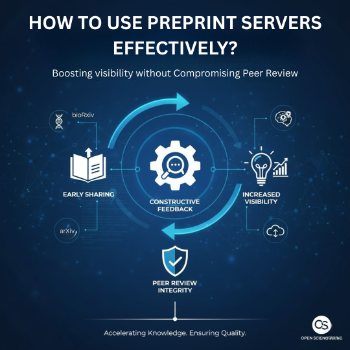In order to effectively use AI in research, we need to strike a balance between innovation, ethics, transparency, and trust In today’s fast-paced research landscape, preprint servers have become an integral part of open science. They allow researchers to share their findings early, receive constructive feedback, and enhance the visibility of their work long before official journal publication.
What Are Preprints?
A preprint is a version of a scientific manuscript shared publicly before undergoing formal peer review. Researchers use preprints to communicate discoveries quickly, claim authorship priority, and engage with the broader scientific community.
Preprints are not yet peer-reviewed, which means their content should be interpreted as preliminary findings. However, they play a crucial role in accelerating knowledge exchange, especially in fast-evolving fields like medicine, biology, and data science.
How to Upload Your Work
Posting a preprint is a straightforward process:
- Choose a reliable preprint server relevant to your discipline.
- Prepare your manuscript, abstract, and any supplementary materials.
- Follow the platform’s submission guidelines.
- Upload and obtain a DOI (Digital Object Identifier) to share and cite your work easily.
Most preprint servers are open-access and free to use. They preserve the timestamp of your submission, ensuring authorship recognition while your paper progresses through journal review.
Why Use Preprint Servers?
Preprints offer multiple benefits:
- Early visibility: Share your work with peers globally before formal publication.
- Authorship priority: Secure recognition for your ideas and findings.
- Constructive feedback: Gather community insights to refine your paper.
- Increased reach: Attract citations and collaborations early.
- Open access advantage: Promote transparency and equitable access to knowledge.
Risks and Considerations
The main limitation is that preprints are not peer-reviewed, meaning they may contain unverified claims. Readers should interpret them cautiously, and authors must make clear that the findings are preliminary. Some journals may also have specific preprint policies, so it’s advisable to check submission guidelines before posting.
Types of Preprint Servers
Preprint servers can be categorized in several ways, by disciplinary scope, region, or ownership. Understanding these categories helps researchers choose the most suitable platform for their work.
By Disciplinary Scope
- Field-specific: Focused on a particular research area.
Examples:
bioRxiv (biology) – https://www.biorxiv.org/
• medRxiv (medical sciences) – https://www.medrxiv.org/
• ChemRxiv (chemistry) – https://chemrxiv.org/
• psyArXiv (psychology) – https://osf.io/preprints/psyarxiv
• engrXiv (engineering) – https://engrxiv.org/
• EarthArXiv (earth sciences) – https://eartharxiv.org/ - Multidisciplinary: Accept submissions across diverse fields.
Examples:
arXiv (broad, but physics/math/computer science dominant) – https://arxiv.org/
• OSF Preprints (all disciplines) – https://osf.io/preprints/discover
• Preprints.org (multifield platform)
• SSRN (social sciences and economics) – https://www.ssrn.com/index.cfm/en/
• Zenodo (general scientific output repository) – https://zenodo.org/ - Regional: Target specific geographic communities.
Examples:
AfricArXiv (Africa-based research) – https://info.africarxiv.org/
• Arabixiv (Arab region research) – https://about.arabixiv.org/
By Owner or Host Type
- Academic institutions: Hosted by universities or research organizations.
Example: arXiv (Cornell University). - Non-profit organizations: Run for community benefit and open science promotion.
Examples: OSF Preprints, HAL (France) – https://hal.science/?lang=en. - Commercial publishers: Operated by for-profit publishers, often integrated with journal workflows.
Examples: Research Square (Springer Nature) – https://www.researchsquare.com/researchers/preprints, Authorea (Wiley) – https://www.authorea.com/preprints. - Independent or integrated platforms: Standalone or connected to research tools.
Examples: figshare – https://figshare.com/articles/preprint/Preprint/25477630, Authorea.
The diversity of preprint servers allows every researcher, whether working in medicine, engineering, or social sciences, to find a platform that suits their discipline and dissemination goals.
Example in Practice
A biology researcher can upload a manuscript to bioRxiv to share preliminary findings. The work may receive valuable suggestions from peers worldwide, leading to improvements before journal submission. The early exposure often helps the paper gain citations even before acceptance.
Therefore, Preprint servers bridge the gap between discovery and publication. They empower researchers to share knowledge rapidly, invite open dialogue, and strengthen their work, without compromising the integrity of peer review. As the research community continues to embrace open science, preprints are shaping the future of transparent and collaborative publication.


